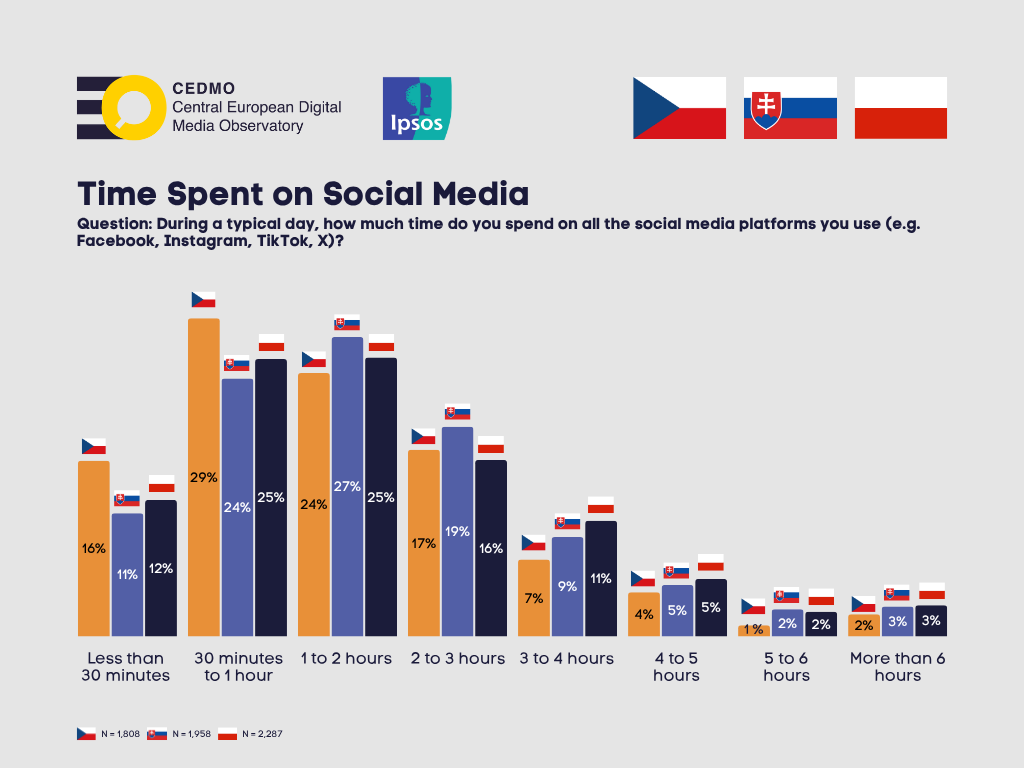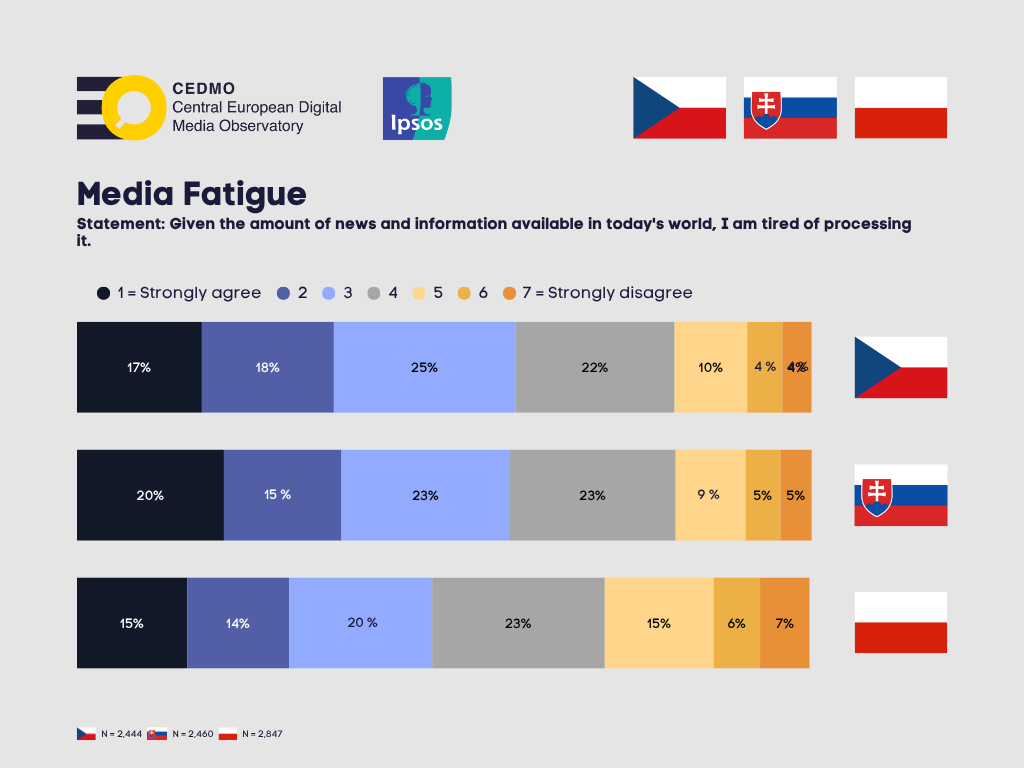
While digital communication connects societies, it also brings fatigue from the flood of information. New research by the Central European Digital Media Observatory (CEDMO) shows that six out of ten respondents (from Central Europe) feel overwhelmed by information. The survey was conducted by data analysts from Charles University in collaboration with IPSOS, in 3 Central European countries: Slovakia, Czechia, and Poland. The research is representative of the population over the age of 15.
General Usage
The opinion tracking survey shows that across Czechia, Slovakia, and Poland, Facebook remains by far the most widely used social media platform (CZ: 88%, SK: 87%, PL: 88%). In Czechia, WhatsApp (73%) now ranks second, surpassing the once-dominant Messenger (68%) in number of users. In Slovakia, however, Messenger (72%) continues to lead ahead of WhatsApp (55%), while in Poland, Messenger also holds second place (69%), followed by YouTube (62%) and WhatsApp (57%). At least half of internet users in all three countries have accounts on both YouTube and Instagram. TikTok stands out most in Poland, where nearly four in ten users (39%) are active on the platform.
TikTok use is concentrated mainly among the youngest generations. Younger users and those in their thirties are also the most likely to maintain Instagram and YouTube accounts, while Facebook continues to be widely used even among older age groups.
Time spent on social media
Social media use is widespread across all three countries, with the largest share of respondents reporting that they engage with it multiple times a day, but less than 10 times. Around one-third of people in each country gave this response (CZ: 30%, SK: 33%, PL: 33%). Conversely, the share of those who do not use social media at all remains relatively small, around one in ten (CZ: 14%, SK: 9%, PL: 11%). In each country, social media use declines noticeably with age, with younger generations being the most active online.
While the average time spent on social media appears relatively similar across the three countries, the data highlights a smaller group of heavy users. Around one in ten respondents spends four or more hours per day on social networks, and roughly 3% report being online for more than six hours daily (CZ: 2%, SK: 3%, PL: 3%). This pattern is consistent across all surveyed countries, indicating that although most people use social media in moderation, a notable share of users devote a substantial portion of their day to online activity.
Heavy use of social media exceeding 3 hours per day is most common among the youngest respondents aged 15 to 24 in all three countries surveyed. While in Poland this applies to 46% of respondents in this age group and in Slovakia to 40%, in the Czech Republic it concerns only 29% of young people surveyed. “The lower level of acknowledged social media usage among young people in the Czech Republic may be due to the greater availability and credibility of traditional media, or perhaps to the poorer availability of high-speed internet connections compared to Poland,” said Ivan R. Cuker, the sociologist in charge of the research.

Fatigue from Information Overload
Given the prevalence of certain topics in the media landscape, the CEDMO survey examined whether people are experiencing media fatigue caused by the constant influx of news. The results for Czechia and Slovakia are quite similar, while Poland shows a noticeably different pattern. In Czechia, 60% of respondents reported feeling media fatigue, compared with 58% in Slovakia. Notably, one in five Slovaks (20%) strongly agreed that they are tired of the volume of news coverage. In Poland, fewer people shared this sentiment; 49% said they experience media fatigue, representing a statistically lower proportion than in the other two countries.
Media fatigue is more common among women, who may engage differently with news content or be more attuned to its emotional impact, while older respondents report slightly lower levels of fatigue, perhaps due to greater experience in filtering information.

Source: CEDMO Tracking V4+5 (commissioned by Charles University, data collection: IPSOS), N (Czech Republic) = 2,444, N (Slovakia) = 2460 N (Poland) = 2,847
Verification of Information
People in all three countries report that they generally check the news they encounter. Slovaks are the most likely to do so (64%), followed by Czechs (62%), while Poles are somewhat less likely to verify information (57%). Across all countries, men and respondents aged 66 and older are the groups most likely to fact-check media content.
This shows that not only does nationality play a role in how people check information, but age and gender are also factors.
Satisfaction with Democracy
Over time, we have consistently observed that among the three countries, citizens in Slovakia express the greatest dissatisfaction with how democracy functions. As of June–July 2025, 47% of Slovak respondents said they are somewhat or very dissatisfied with democracy, less than half of the population aged 15 and over. Another 35% described their stance as neutral, saying they are neither satisfied nor dissatisfied.
In Czechia, dissatisfaction is notably lower, with 36% of respondents expressing discontent and around a third (32%) remaining neutral. In Poland, attitudes differ significantly: only 23% of citizens reported being dissatisfied with the functioning of democracy, while 36% chose a neutral position.
Regional Comparison and Conclusion
Czechs spend less time online, with the highest shares in the lower time spent per day (less than 30 minutes) and the lowest shares in the higher time spent online (more than 3 hours). But they are not that far behind their neighbours. However, concerning what apps they use, most of the respondents are using Facebook, which shows that Central Europe is favouring Facebook over other social media platforms. Older generations also use Facebook substantially. New social media platforms are emerging, mostly targeting younger generations, with TikTok being a prime example.
Central Europeans seem to be overwhelmed with the quantity of information they receive every day, all around social media.
The main difference between these three countries is in trust in democracy, with Slovakia expressing much greater dissatisfaction than the other two.
The thematic report is available in the following versions
- CEDMO Special Brief (data for Czechia, Slovakia, Poland) – in Czech
- CEDMO Special Brief (data for Czechia, Slovakia, Poland) – in Slovak
- CEDMO Special Brief (data from Czechia, Slovakia, Poland) – in Polish
- CEDMO Special Brief (data from Czechia, Slovakia, Poland) – in English
* The data and findings presented in this article are based on the CEDMO Tracking V4+5 survey. This is an international research project focused on monitoring the attitudes of the European public towards current social issues (primarily disinformation and hoaxes, information disruptions, and the evaluation of democracy). The long-term research also focuses on mapping the development of these trends. It includes five waves of surveys conducted every two months and takes place in nine European Union countries: the Czech Republic, Slovakia, Poland, Hungary, Slovenia, Estonia, Finland, Germany, and France. The first wave took place from June 16 to July 11, 2025, and involved 25,024 respondents over the age of 15.

*The survey is funded by the National Recovery Plan – a project entitled MPO 60273/24/21300/21000 CEDMO 2.0 NPO.
*The publication “CEDMO Fact-checking Brief: Overview of Outputs for the Third Quarter of 2025,” referred to in the text, was created with support from the National Recovery Plan – project entitled MPO 60273/24/21300/21000 CEDMO 2.0 NPO.
